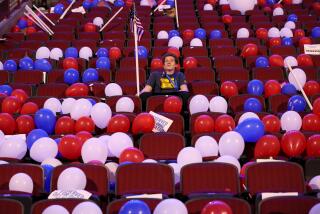Final days of Obama-Romney race: No hard choices – just spend
- Share via
WASHINGTON — The final weeks of a presidential election used to be a time of hard choices for cash-strapped campaign strategists.
Not this year.
Having rejected public financing, which would have imposed spending limits, President Obama, Mitt Romney and their political parties entered the final 20 days of the race with a combined $293 million on hand.
Their sizable cash reserves represent a sharp departure from past White House contests and have altered the way the campaigns plotted their strategies — and their final advertising buys — in the last stretch of the race.
“They don’t have to make difficult spending choices,” said Republican strategist Steve Schmidt, who served as a top campaign official for Sen. John McCain of Arizona in his 2008 presidential bid. “They both have enough resources to do everything they want to do.”
That’s one reason the playing field appeared to have widened this week, with Romney’s campaign making incursions on the air in Pennsylvania, Michigan and Minnesota — states that had been considered safe for Obama.
“You have so much money that you can afford to launch these forays into these places you might not have a shot of winning, but you want to keep in play to keep a narrative alive,” said Democratic strategist Tad Devine.
It’s a far cry from the 2000 race, when — 17 days before the election — Devine concluded that Vice President Al Gore’s campaign had to yank its ads off the air in Ohio to concentrate on Florida.
“One had to go,” he recalled wistfully.
That was because Gore had agreed to accept public financing, giving him just $67.5 million to spend in the general election.
In 2008, Obama became the first presidential candidate to decline general election public funding and its accompanying spending cap — which allowed him to outspend McCain by $285 million.
“It was the feeling of constantly being smothered,” Schmidt recalled. “Whenever we would see some movement in the polls, we would make an adjustment with our television strategy, and then the Obama campaign would double their spending.”
The huge imbalance set the stage for both candidates to reject public funding in this year’s campaign, triggering a financial arms race. Together with their parties, Obama and Romney are on track to raise $2 billion total.
As of Oct. 17, the Republican challenger and his affiliated party committees still had $169 million on hand. The Democratic incumbent and his party allies held nearly $125 million.
Obama, however, held more money directly in his campaign committee, the result of raising a larger share in small donations. Because only candidates get the lowest market rate for TV ads, Obama has been able to maintain a bigger presence on the air than Romney, who has relied on outside groups to make up the difference.
Both candidates have continued to press for more cash, sending out urgent emails as late as Friday pleading for more funds.
The bulk of their money is going to buy more airtime. Through Oct. 29, nearly 1.1 million commercials had already run on broadcast and national cable television — 39% more ads than during the same period in 2008, according to a study released Friday by the Wesleyan Media Project, which analyzes data from the ad-tracking firm Kantar Media/CMAG.
The air assault has intensified as election day nears, with 309,000 ads airing between Oct. 1 and 29, the project found.
During the week of Oct. 22, Obama’s campaign dropped $26 million on national cable and broadcast television ads. Romney and the Republican National Committee spent nearly $14 million.
Both candidates had a presence in the top markets across the battleground states — Obama was in 57 media markets last week, and Romney was in 50.
Flush cash reserves have allowed both campaigns to adopt “all-of-the-above strategies,” said Michael Franz, co-director of the Wesleyan project. “You’re just seeing a ton of effort in everything.”
The Obama campaign has devoted the vast share of its resources to a relentless air assault that began during the summer, as well as a huge field operation.
The Romney campaign is using its money for a stepped-up ad blitz. It also is producing increasingly elaborate events. Outdoor rallies are now marked by more sophisticated staging and lighting, and supporters often get props, such as white and blue Romney-Ryan thunder sticks. Bursts of fireworks closed out recent late-evening events.
At a nighttime rally last week at Red Rocks Ampitheatre in Golden, Colo., an open-air arena that charges $100,000 for private events, Romney’s advance team illuminated the towering boulders with blue lights and transformed the stage with grass, small pine trees, bushes, fall flowers and split-rail fences.
The scene, shot by campaign videographers, is all but certain to turn up in Romney’s closing ads.
Staff writer Maeve Reston contributed to this report.
More to Read
Sign up for Essential California
The most important California stories and recommendations in your inbox every morning.
You may occasionally receive promotional content from the Los Angeles Times.










